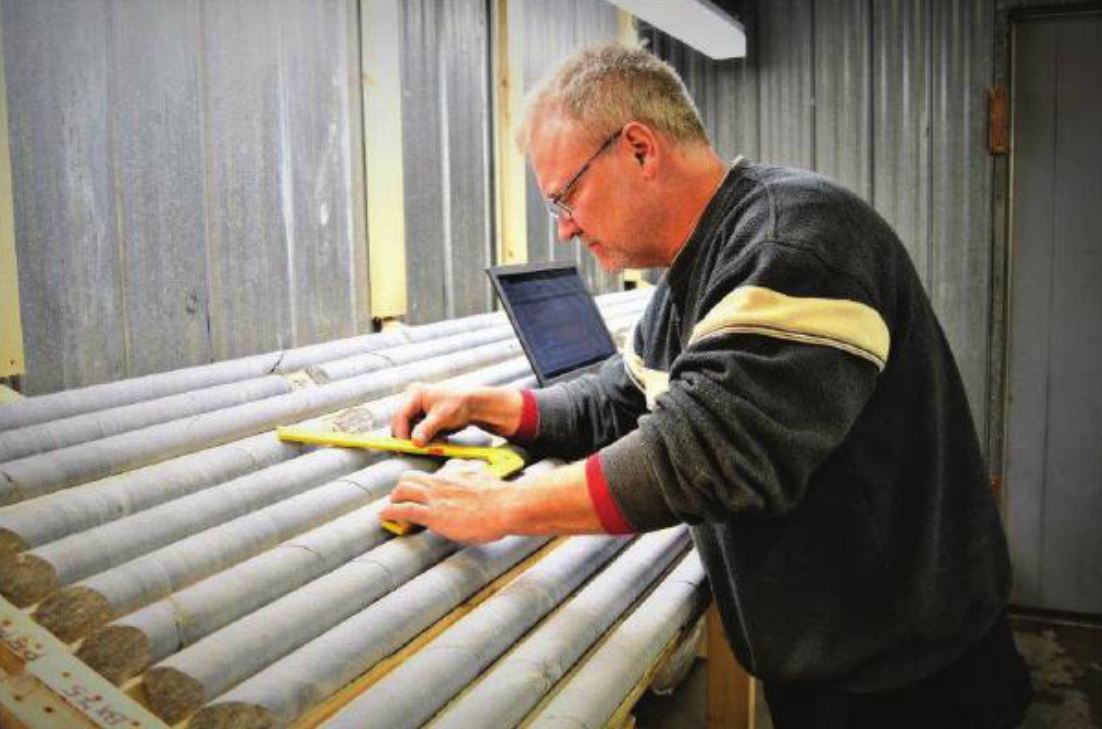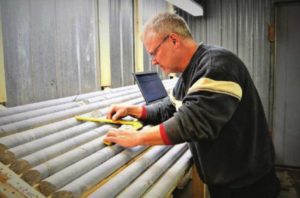Callinex reports zinc and copper assays from Manitoba VMS project

Jason Levers, Project Geologist, logging diamond drill core from the Pine Bay VMS Project at Callinex's facilities near Flin Flon, Manitoba. Photo courtesy Callinex Mines Inc.

Callinex Mines Inc. [CNX-TSXV, CLLXF-OTCQX] on Friday January 12 released results from a 2017 summer drilling campaign at the Pine Pay and Big Island Projects in Manitoba’s Flin Flon Mining District.
The Pine Bay and Big Island projects are located east of HudBay Minerals Inc.‘s [HBM-TSX, HBM-NYSE] 777 Mine and processing facilities. As the 777 operation has less than four years of mine life, it will soon require additional ore.
Callinex said the summer drilling campaign consisted of 10 holes, or 5,350 metres of drilling to conduct a maiden program at the company’s Big Island Project and follow-up on a new zinc and gold rich volcanogenic massive sulphide (VMS) mineralization at the Pine Bay Project.
The maiden drill campaign at the Big Island Project consisted of five holes or 1,480 metres. Big Island host the Tara Lake Deposit, one of the highest-grade zinc-rich discoveries within the Flin Flon Mining District. Previous drill results include 7.4 metres of 35% zinc equivalent, 12.4 metres of 34% zinc equivalent and 19.6% of 24% zinc equivalent.
The five-hole program was designed to test the down-plunge potential, confirm the orientation of a fault reported to have displaced part of the deposit and test for lateral extensions of the mineralization.
The company said it confirmed that the fault is likely responsible for displacing a portion of the deposit along the projected plunge. Drill hole TZ17-03 tested for a possible fold nose closure and intersected 7.9 metres of 2.5% zinc and 0.42 g/t gold at a starting depth of 69.5 metres, including 0.2 metres of 28% zinc, 1.9 g/t gold and 42.7 g/t silver at a starting depth of 76.9 metres.
Significantly, multiple borehole surveys identified conductors down-plunge that represent potential for mineralization in a proximal setting, the company said. For example, hole TZ17-02, which was drilled approximately 500 metres south along the projected plunge line, identified an untested borehole pulse electromagnetic conductor with a strike extent of 450 metres and a plunge extent of 675 metres, with a coincident magnetic signature indicative of massive sulphides.
This target will be part of an upcoming 2018 drilling program and the result will assist the company to determine whether to proceed further with the option agreement, Callinex said in a press release.
A follow-up program was also completed on the Pine Bay Project. It was designed to test for continuity between two drill holes that had interested 10.3 metres, grading 13.1% zinc equivalent and 2.6 metres of 3.0% copper equivalent. However, the company said there appears to be a significant dyke or sill that could limit the overall potential size of this zone.
The Pine Bay Project covers a significant portion of the Baker Patton Felsic Complex, one of the largest and most highly altered packages of felsic volcanic rocks within the Flin Flon Greenstone Belt.
The company said it is planning to complete a 3-D induced polarization survey in the area to model lowly conductive pyrite mineralization that may occur over a series of smaller deposits.
Drill hole PBM-026 expanded a mineralized zone associated with the Baker Patton deposit and intersected significant stringer mineralization from 399.2 metres to 462.1 metres, including 3.8 metres, grading 2.4% copper at a starting depth of 399.2 metres along with a separate intersection of 9.6 metres, grading 1.2% copper at a starting depth of 452.5 metres, including 2.2 metres of 1.9% copper at a starting depth of 452.5 metres.
Callinex shares were up a half cent to 34.5 cents on Monday January 15. The 52-week range is 51 cents and 28 cents.
